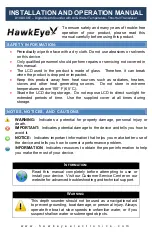
w w w . h a w k e y e e l e c t r o n i c s . c o m
STEP 3
Drilling the Hole
1. After selecting the mounting location based on
STEP 2, place the rubber gasket inside the hull
against the mounting location.
(illustration A)
2. Ensure that there is at least 1/2” (12 mm) of flat
surface area around the rubber gasket.
(illustration
B)
3. Place a mark in the center of mounting location.
(illustration C)
4. Drill a 1/8" (3 mm) pilot hole on the mark. If there is
a rib, strut, or other hull irregularity on the hull
bottom near the selected mounting location, drill
from the outside.
5. Using a 2" (51 mm) hole saw, cut a hole from
outside the hull. (Illustration A)
6. Using sandpaper and mild house hold detergent,
sand and clean the area around the hole (inside
and outside). Make sure to remove all rough spots
and petroleum residue.
STEP 4
Sealing and Installing
1. Remove the nut and rubber gasket from the
sensor.
2. Apply a bead of marine sealant around the lip of
the sensor housing.
(illustration D)
3. From outside the hull, feed the cable through the
hole (plug first) into the mounting hole until all the
cable is inside the hull.
4. Insert the sensor into the hole using a twisting
motion to squeeze out excess sealant.
5. From inside the hull, align the arrow on the housing
towards the bow of the vessel.
(illustration E)
6. Slide the rubber gasket onto the housing.
7. Screw the hull nut into place, being sure the arrow
on the housing is still positioned forward toward the
bow.
N
OTICE
:
Hand-tighten only.
Do not over-tighten.
8. Remove the excess sealant on the outside of the hull.
½” Flat Surface
Rubber Gasket
X
A
B
C
D
E


















